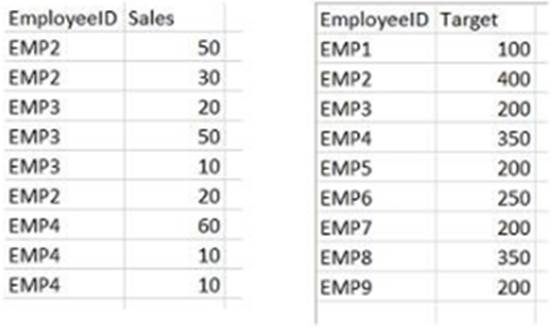QlikView QSDA2018 Qlik Sense Data Architect Certification Exam Online Training
QlikView QSDA2018 Online Training
The questions for QSDA2018 were last updated at Feb 08,2025.
- Exam Code: QSDA2018
- Exam Name: Qlik Sense Data Architect Certification Exam
- Certification Provider: QlikView
- Latest update: Feb 08,2025
Refer to the exhibit.


A data architect has two tables that contain Sales and target data for employees. The tables are loaded into Qlik Sense and are associated by EmployeeID. The data architect creates a bar chart of total Sales vs. Target. The architect notices some values for target are too high, and employees with NO sales should be excluded.
Which function should the data architect use to resolve these issues?
- A . Left Join
- B . Inner Join
- C . Left Keep
- D . Outer Join
Refer to the exhibit.


A data architect has two tables that contain Sales and target data for employees. The tables are loaded into Qlik Sense and are associated by EmployeeID. The data architect creates a bar chart of total Sales vs. Target. The architect notices some values for target are too high, and employees with NO sales should be excluded.
Which function should the data architect use to resolve these issues?
- A . Left Join
- B . Inner Join
- C . Left Keep
- D . Outer Join
Refer to the exhibit.


A data architect has two tables that contain Sales and target data for employees. The tables are loaded into Qlik Sense and are associated by EmployeeID. The data architect creates a bar chart of total Sales vs. Target. The architect notices some values for target are too high, and employees with NO sales should be excluded.
Which function should the data architect use to resolve these issues?
- A . Left Join
- B . Inner Join
- C . Left Keep
- D . Outer Join
Refer to the exhibit.


A data architect has two tables that contain Sales and target data for employees. The tables are loaded into Qlik Sense and are associated by EmployeeID. The data architect creates a bar chart of total Sales vs. Target. The architect notices some values for target are too high, and employees with NO sales should be excluded.
Which function should the data architect use to resolve these issues?
- A . Left Join
- B . Inner Join
- C . Left Keep
- D . Outer Join
Refer to the exhibit.


A data architect has two tables that contain Sales and target data for employees. The tables are loaded into Qlik Sense and are associated by EmployeeID. The data architect creates a bar chart of total Sales vs. Target. The architect notices some values for target are too high, and employees with NO sales should be excluded.
Which function should the data architect use to resolve these issues?
- A . Left Join
- B . Inner Join
- C . Left Keep
- D . Outer Join
Create a new field to the OrderDetails table: ApplyMap (‘UnitCost_Map’, ProductID, 0) * Quantity as COGS
Two companies have merged and full database integration is planned for next year.
The data architect needs an interim solution to view all employee data from both companies.
– The tables come from different systems
– Both companies have similar Employees tables
– Both tables have identifiers for Employee and some other attributes (e.g., geographical information)
– The tables also have some fields that do NOT match (e.g., Social Security Number and Bank Account)
Which problem occurs when the two tables are loaded into Qlik Sense?
- A . Link tables are created
- B . Synthetic keys are created
- C . An auto concatenation occurs
- D . A circular reference occurs
Two companies have merged and full database integration is planned for next year.
The data architect needs an interim solution to view all employee data from both companies.
– The tables come from different systems
– Both companies have similar Employees tables
– Both tables have identifiers for Employee and some other attributes (e.g., geographical information)
– The tables also have some fields that do NOT match (e.g., Social Security Number and Bank Account)
Which problem occurs when the two tables are loaded into Qlik Sense?
- A . Link tables are created
- B . Synthetic keys are created
- C . An auto concatenation occurs
- D . A circular reference occurs
Two companies have merged and full database integration is planned for next year.
The data architect needs an interim solution to view all employee data from both companies.
– The tables come from different systems
– Both companies have similar Employees tables
– Both tables have identifiers for Employee and some other attributes (e.g., geographical information)
– The tables also have some fields that do NOT match (e.g., Social Security Number and Bank Account)
Which problem occurs when the two tables are loaded into Qlik Sense?
- A . Link tables are created
- B . Synthetic keys are created
- C . An auto concatenation occurs
- D . A circular reference occurs
Two companies have merged and full database integration is planned for next year.
The data architect needs an interim solution to view all employee data from both companies.
– The tables come from different systems
– Both companies have similar Employees tables
– Both tables have identifiers for Employee and some other attributes (e.g., geographical information)
– The tables also have some fields that do NOT match (e.g., Social Security Number and Bank Account)
Which problem occurs when the two tables are loaded into Qlik Sense?
- A . Link tables are created
- B . Synthetic keys are created
- C . An auto concatenation occurs
- D . A circular reference occurs
Latest QSDA2018 Dumps Valid Version with 50 Q&As
Latest And Valid Q&A | Instant Download | Once Fail, Full Refund

